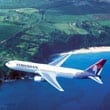September 29th, 10:48 a.m. PDT. Seismologists report a substantial earthquake epicentered on the ocean floor 120 miles south of the tiny bacon-strip island of American Samoa.
Within minutes the earthquake had spawned a tsunami with terrifying consequences.
By 8:00 p.m. PDT, the news was shattering. Cars, homes, personal possessions were destroyed or swept away by the massive waves. And there were deaths. Those too old to heed the tsunami warning and children ambling to school oblivious of the danger descending upon them disproportionately accounted for the dead.
Back in the U.S. a snap decision was made to mount and launch a disaster relief mission to fly much needed supplies and help to the beleaguered island.
At a moment’s notice all available hands were called into action. Enthusiastic discipline prevailed. First, the aircraft schedule was shuffled to provide a plane. Check. Second, the situation at ground-zero was assessed to ensure the plane could land on the runway and that the fuel for the return flight had not been contaminated by the tsunami. Check. The FAA and TSA were contacted to ensure all systems go. Check.
With that, volunteers were urgently sought and over 100 quickly came forward to fill just 34 spots. Relief supplies were assessed and instantly purchased with a phone call to Wal-Mart’s regional headquarters. Some 40,000 pounds of water, food, medical supplies and more were sorted, loaded and delivered to the awaiting aircraft. Logistics for smooth distribution upon landing were planned in great detail.
Communications experts and equipment — satellite phones, computers, IT cables — were quickly procured and brought onboard. A call went out that the unoccupied seats would be made available for any medical or government personnel and even the media. A medical disaster team, FEMA, the Coast Guard, two newspapers, and three television stations eagerly accepted the offer of transportation. Volunteers packed sheets and pillows with the full expectation of sleeping rough for a night or two.
September 30th, 4:00 p.m. PDT. A mere eighteen hours after the initial decision, the plane took off precisely at this pre-established time. A government operation? A launch from a military base?
No, it was a Hawaiian Airlines Boeing 767. I was one of the volunteers and in full disclosure, I am married to an employee.
On the ground the destruction was absolute, shocking. As if Atlas himself had picked up the houses like toy-boxes, flipped them upside down, applied a fire-hose and shaken the contents with such destructive might that nothing was left intact. A bathroom sink in a living room with the soaking mattress on top. Roofs wrapping around vehicles now impaled against trees and even in window holes. Sand-filled microwaves and irons in the yard buried in mud. Structurally, it was like a raging bulldozer had unremorsefully dissected interiors, transforming walls and ceilings into a helter-skelter piles of twisted wood, plaster, and wallboard. Windows became holes with no shred of curtains or blinds remaining. There were no half-measures, either the waves had failed to reach your elevation or they destroyed everything in their way.
On the slab concrete foundation of what had a morning earlier been a small store a bouquet of flowers wreathed the photo of a missing six-year-old girl. Her father sat catatonically nearby.
It is not a surprise that among the very first on the scene with life-sustaining supplies was a company from the private sector. Why? Because the culture of initiative and risk-taking is critical to a successful business and precisely the attributes required to put together a plan against unknown circumstances and uncertain outcomes. Companies aren’t saddled with the paralyzing bureaucracy of the government. For the most part, they don’t get entangled in the self-defeating morass of regulations and the government’s bloated chains of command — like FEMA during Katrina — when making decisions. Nor do they march to the drum of political necessity. Decisions are based on market-based needs, not what votes they’ll bring in.
No better illustration can be had than in Samoa where a mid-sized airline — with no experience or responsibility for relief operations — responded more quickly and boldly than most governmental and non-governmental institutions whose very raison d’être is disaster relief.
A risk culture does not imply the wanton risks of the over-leveraged Lehmans of the world that create huge vulnerability. Rather, it’s the unencumbered thinking that enables a couple of companies to buy $20,000 of supplies without having to go through a hierarchical ladder of head-scratching decision-makers checking off regulations every step of the way. It’s the unmitigated “yes we can” — from the Bank of Hawaii — which made their branches available as distribution points because… they’re not under TARP. This bank was wise enough to stay away from the government-backed subprime mortgage fiasco, further enabling them to freely match the purchase of relief supplies.
It’s the fluid ability that allowed Wal-Mart to overnight gather 40,000 pounds of goods into cargo palettes, load it onto trucks for delivery to the Moby Dick–sized belly of that purple-tailed 767 and Webco, a successful small-business in Honolulu, to proudly offer its goods. Without hesitation.
Indeed, Max Weber the 19th-century sociologist couldn’t have said it better: “The individual bureaucrat cannot squirm out of the apparatus in which he is harnessed.” This is precisely what the people’s opposition to the government’s control of banks, health care reform and so on is railing against. Our ancestors didn’t take the enormous risk of traveling across the Atlantic to inhabit a new world that would be a carbon-copy of the rules-shackled society they left behind.
Like Hawaiian Airlines, they wanted to take off — running with the freedom to be enterprising.






















